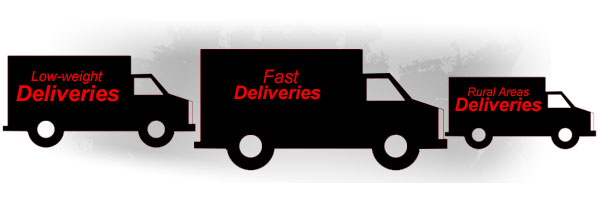Best Practices for Optimizing Online Order Fulfillment and Merchandise Delivery
There are three stages to finalizing a sale: converting the prospect, processing the transaction, and shipping the merchandise.
Within the shipping phase, there are two key components: order fulfillment and merchandise delivery.
Order Fulfillment
Companies sacrifice big money for marketing that draws potential customers to their site and converts those visitors into paying customers. Once the customer places an order, however, many companies drop the ball.
It’s important to realize that order fulfillment is the last opportunity to make an impression on the customer.
Handled correctly, a good last impression can solidify the customers’ loyalties and bring them back in the future. However, a bad fulfillment experience can result in the potential loss of a customer for life.

Choosing Order Fulfillment Software
To optimize the order fulfillment process, many companies rely on in-house software. Today’s intuitive software can manage inventory levels, order processing, shipping, tracking, and much more.
Fulfillment software may provide opportunities to:
- Manage new and existing orders
- Track and view inventory
- Forecast future inventory needs
- Alert managers of dwindling inventory levels
- Verify returns
- Manage invoices
- Generate reports
Regardless of the size of the business, merchants must find a software that can grow with the company and meet its needs over time.
Pros and Cons of Outsourcing Order Fulfillment
Rather than handle order fulfillment in-house, some companies elect to outsource their shipping needs.
Initially, businesses are typically able to manage their own order volume. As the business grows, however, and the volume of orders increases, it can affect the business’ ability to be productive in other areas.
Outsourcing allows the company to free up storage or warehouse space, as well as allows management to focus on the other aspects of the business.
Pros of Outsourcing
Outsourcing has several benefits that may appeal to growing companies:
- Order fulfillment time is reduced. Generally, fulfillment companies have shipping centers located around the country, allowing customers to receive orders within 1-2 days.
- Scalability of the business is improved. As a company grows, there are no additional infrastructure or inventory controls that are necessary; the fulfillment center handles the additional shipping needs easily.
- Expansion into foreign countries is easier. Companies that outsource can easily expand into other countries without the hassle of deciphering international shipping regulations, as that is all handled by the fulfillment company.
Outsourcing may be appropriate for a company with:
- Limited inventory SKUs: The more SKUs, the higher the costs of outsourcing. If a company has a small number of items available, outsourcing may be a viable option.
- Small products: Larger products require more warehouse space and, therefore, are generally more expensive to outsource.
- Simple packaging: If products can be shipped and packed quickly, without specialized instructions or packaging, outsourcing is an effective order fulfillment option.
Cons of Outsourcing
With the good comes some bad:
- Returns: Customer returns can be an issue for companies that outsource shipping. Merchants must determine who will handle the product returns, who will determine the suitability of a product to be resold, and who will address customer concerns regarding shipping. With an outsourced fulfillment process, the company loses control over some of these aspects and may be forced to unilaterally accept returns which can negatively impact profitability.
- Cost: Products that require specialization or have intricate packaging tend to become cost-prohibitive as an outsourced item.
Pros and Cons of Drop Shipping
A third order fulfillment option is drop shipping.
Merchants who use drop shipping act as a middleman between the consumer and the manufacturer. Merchandise delivery is from the manufacturer to the consumer; the merchant never physically handles the items at all.
As with the other fulfillment methods, there are both pros and cons to choosing drop shipping.
Pros of Drop Shipping
- Little to no start-up capital is required. Because a merchant only purchases items after receiving an order, there is little up-front investment needed.
- Minimal overhead is needed. Merchants dealing in drop ship businesses can run their business with a simple laptop from a home office.
- A wide product range can be offered. Offering a wider range of products is possible because items aren’t purchased until the point of sale.
- It’s easy to scale. Growing the business is easy when the majority of additional work is handled by the drop shippers. There may be an increase in customer service needs, but typically merchants dealing with drop shipping expand easily.
Cons of Drop Shipping
- Merchants report poor margins. With minimal startup costs, many merchants sell items at extremely reduced prices in an effort to gain sales. As a result, customers may select another drop ship merchant simply because a cheaper option is available. To stay competitive, merchants need to offer rock-bottom prices.
- Limited inventory control. Merchants have no control over the inventory that drop shippers have. Merchants often find themselves between the customer who placed an order and the drop shipper who doesn’t have it in stock. There are ways to minimize this occurrence, but it is still a possibility.
- Errors happen. If a mistake is made during order fulfillment or delivery, the customer will expect the merchant to correct it. Order packing mistakes, mediocre products, and missing items can all be costly and frustrating issues that merchants must deal with.
- Fraud can happen. Overseas drop shippers in high risk countries increase the risk of fraud.
The responsibility for what is sold and successfully delivered rests with the merchant.
[Tweet "Order fulfillment is the merchant's last chance to make an impression. Will it be good or bad?"]Merchandise Delivery
Again, the merchandise delivery process is just as important as any other stage that happens before it. Merchants need to give careful consideration to the delivery process.

Choosing the Best Carrier
Most businesses benefit from using a variety of shipping providers.
- The size and weight of the merchandise often dictates the cost for shipping it. Merchants who work with various shipping providers can choose the carrier best suited for the size of the purchase. For example, the U.S. Postal Service usually has less expensive shipping costs for low-weight deliveries.
- The scope of delivery areas will vary with carriers. For example, USPS has a wider delivery area than the other carriers, covering the rural parts of the country. In many cases, FedEx and UPS contract with the USPS to handle their deliveries in areas they do not operate.
- UPS and FedEx, however, may be a better option for the customer looking for a faster delivery.
- Since some carriers won’t ship to PO boxes, merchants need to work with an alternate shipping service that does.
Delivery Options Available to Consumers
Merchants must determine how to provide the optimal customer experience without increasing costs.
Shipping Costs
Consumer polls have made it clear: shoppers want free shipping. As a merchant establishes delivery options, free shipping can be a valuable tool to attract customers.
Ironically, consumers are willing to pay more to get free shipping—which is a good thing! To avoid an increase in expenses, businesses can build the shipping fees into the cost of products. Or, merchants can offer free shipping above a certain order total.
Expedited Shipping
By offering an expedited shipping option, businesses are able to satisfy customers wishing to purchase last minute orders.
Customers expect to pay additional costs to expedite shipping, allowing the business to pass the expense on.
Expected Delivery Dates
Merchants need to inform the customer of the expected date of delivery. It is important to include the processing and fulfillment period to give a realistic time frame.
Notifying customers of any potential delays or problems with delivery can help avoid chargebacks or transaction disputes.
High-Risk Orders
Fraudsters often take advantage of overnight shipping; they want to turn a profit quickly before the crime is detected.
Orders that include expensive, in-demand items for overnight delivery may require additional scrutiny. This is particularly true of orders being shipped internationally.
To reduce the potential for fraudulent transactions, merchants should delay the shipment of high-risk orders for 24-48 hours. Publicize this delay in the checkout process so legitimate customers aren’t inconvenienced.
Online Tracking and Signature Confirmation
Regardless of the carrier used, online tracking information should be made available.
Tracking keeps both the consumer and merchant informed and aware of the merchandise delivery progression. Additional security can be acquired through signature confirmation for large sales.
Order tracking is generally not available for shipments travelling outside the United States. Use discretion in handling international shipping.
Want more information?
Check our knowledge base article that explains how delivery confirmation impacts chargeback management.
Shipping Insurance
Despite a company’s best intentions, things can go wrong during delivery. Shipping insurance can be invaluable for customers receiving expensive or fragile items.
Merchandise that arrives with packaging that is visibly damaged should be refused by the customer. If possible, merchants should have the shipping company return the item to facilitate the insurance claim. Merchants must instruct customers to keep all packaging until they have verified the product is complete and undamaged.
There are some limitations to shipping insurance, so merchants should carefully consider the extra expense before utilizing the service. Insurance exception may impact liability (for example, the type of packaging, the shipping company used, and the declared value).
Most claims must be filed within a specific amount of time, so merchants should take action quickly.
Preventing Broken or Damaged Merchandise
Preventing broken or damaged merchandise is a necessity to safeguard company profits and reduce the risk of chargebacks.
When a claim is made for broken or defective merchandise that is not covered by shipping insurance, a merchant has a couple options:
- Items under warranty can be returned to the manufacturer directly.
- The customer can ship items back to the merchant for a refund.
- The merchant can provide a replacement item or immediate refund for low-ticket items. By not forcing the consumer to go through the hassle of returning the merchandise, the merchant decreases the odds of a chargeback.
To prevent confusion, have a clearly defined return policy that details the process, as well as any time limitations.
Chargebacks Associated With Delivery Issues
Chargebacks are commonly associated with order fulfillment and merchandise delivery. Two of the most common chargeback reason codes used are:
| Visa Reason Code | MC Reason Code | Title and Explanation | Causes |
| 30 | 4855 | Merchandise not received
Merchandise was not received or not received by the agreed upon delivery date |
The merchant failed to send the product.
The merchant billed the cardholder before sending the products. The merchant didn’t send the items by the agreed upon delivery date. |
| 53 | 4853 | Merchandise not as described or defective
The merchandise was damaged or defective upon its arrival or was not the same as described |
The merchant sent the wrong item.
The item was damaged during delivery. |
Merchants can, and should, take the necessary steps to prevent these chargebacks.
To prevent chargebacks due to merchandise not received, merchants need to:
- Use business best practices at all times.
- Pre-authorize the charge amounts and only bill customers when products are shipped.
- Utilize delivery confirmation systems, including delivery tracking and signature confirmation.
- Notify customers of realistic delivery times. Include time for processing and packaging orders to prevent unrealistic expectations. Offer expedited shipping and processing for customers who wish to receive items faster.
To prevent merchandise not as described chargebacks:
- Describe products accurately.
- Use appropriate shipping methods to ensure products arrive intact.
- Train staff on order fulfillment processes to make sure the items match the orders.
- Have a clearly posted return policy. Use ‘click to accept’ options to ensure the customer received notification of all policies including time frame and stipulations for returns.
Once a chargeback has been filed, merchants have the opportunity to validate the transaction through the process of representment.
To successfully win a representment, the merchant must submit documentation that contradicts the cardholder’s claim. For chargebacks related to the delivery of merchandise, compelling evidence might include:
- Delivery conformation documents
- Emails or other documented communications
- Published delivery timelines
- Applicable policies and regulations
Unfortunately, preventing and disputing chargebacks associated with order fulfillment and delivery conformation is complicated. If you’d like help creating a comprehensive strategy to minimize risks, contact Chargebacks911® today.








